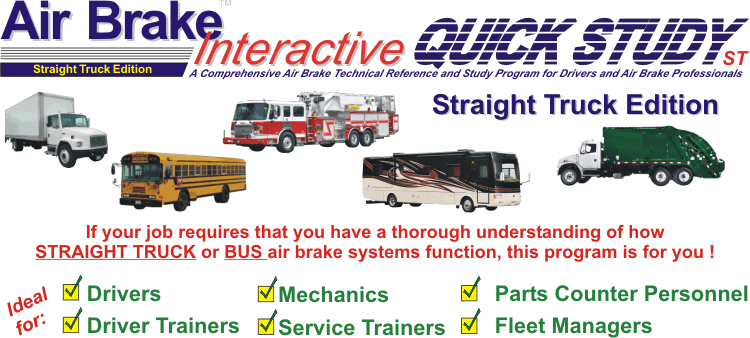
AIR BRAKE Interactive QS Straight Truck & Bus (QS-ST)
AIR BRAKE Interactive QUICK STUDY ST Straight Truck & Bus is a user-interactive, self-study multimedia program designed to provide drivers, driver trainers, mechanics, service trainers, parts counter personnel, and fleet service managers with a thorough understanding of straight truck and bus air brake systems.
AIR BRAKE Interactive QUICK STUDY ST isa multimedia user-interactive air brake technical reference and knowledge resource drivers, driver trainers, mechanics, service trainers, parts counter personnel, and fleet service managers.
What’s Included:
Sample Animations
If your job requires a thorough understanding of how Straight Truck and Bus air brake systems function, this program is for you.
Ideal for:
| »Drivers | »Mechanics | » Parts Personnel |
| » Driver Trainers | » Service Trainers | » Fleet Managers |
We’re SERIOUS about IMPROVING AIR BRAKE EDUCATION for everyone!
Recognizing the need for vastly improved air brake knowledge and education in the truck transportation industry, we’ve instituted a new QUICK STUDY licensing and pricing policy. Fleets, heavy vehicle repair facilities, heavy-duty parts store chains, vehicle safety inspection authorities, and trucking associations can now acquire our AIR BRAKE Interactive QUICK STUDY Truck & Bus program in a manner and at a price that meets their exact needs.
We are committed to working with each client, on one, to formulate a solution for their specific air brake training needs. Whether you simply need a fast and effective air brake educational program, for your driver trainers to present, or you want to provide each driver with his or her air brake self-study program, we’ll work with you to make it happen.
Visual Learning at its BEST
The AIR BRAKE Interactive QUICK STUDY ST sets a new standard for visual learning by employing detailed visuals and state-of-the-art multimedia animations of air brake circuits and components. With voice narration accompanying every illustration and animation, this program enables you to see, hear, and fully understand the functionality of a typical air brake system.
Beyond just learning about system operations, you will gain practical knowledge on how to:
- Conduct quick and effective air system inspections.
- Perform simple yet accurate functional tests.
- Carry out routine daily maintenance efficiently.
And the best part? NO READING REQUIRED! Every step is voice-narrated, ensuring an engaging and easy-to-follow learning experience tailored for all learners.
A Fully Functional Air Brake Board – ON YOUR COMPUTER!
In addition to discussions, visuals, and animations illustrating vehicle dynamics and the function of numerous individual air system components and circuits, AIR BRAKE Interactive QUICK STUDY ST provides you with what is essentially a complete and fully functional MULTIMEDIA ANIMATED AIR BRAKE BOARD. A physical air brake board capable of visually demonstrating the function of a typical air brake system would cost tens of thousands of dollars, not to mention that physical air brake boards are large, cumbersome,e and heavy, making them extremely difficult to transport. With AIR BRAKE Interactive QUICK STUDY ST you’ll have a fully functional multimedia air brake board – on your computer!
Program Run and Study Times
The AIR BRAKE Interactive QUICK STUDY ST multimedia presentation provides a comprehensive learning experience through approximately 58 minutes of voice-narrated visuals and air system animations. While the core presentation is concise, the actual time required to complete the entire program, including instructor-led discussions and student interactions, will vary. On average, this can take between 2 to 3 hours.
Instructors have the flexibility to tailor the program delivery to suit specific student needs or classroom schedules. They can choose to present the entire program or focus on selected components or modules as necessary. This modular approach ensures adaptability for a range of educational scenarios, optimizing learning outcomes and accommodating time constraints.
Your Custom AIR BRAKE Interactive QUICK STUDY ST Program
The AIR BRAKE Interactive QUICK STUDY ST program offers a personalized touch by being custom-prepared to include your fleet, company, or school’s name and logo. This feature ensures that the program aligns with your organization’s identity, making it a tailored and professional training solution for your team or students.
For more information on each module, click on the “v”.
QS-ST Content

For more information and to discuss your specific needs, ideas, or questions with one of our expert teaching resource developers, we encourage you to contact us. Our team is dedicated to creating high-quality, engaging, and effective teaching materials tailored to your unique requirements. Please don’t hesitate to contact us via:
Bryan Duross
TECHNICAL TRAINING SERVICES
Telephone: 519-621-0708
E-Mail: bduross@sentex.net
For a FREE full-version demo, Contact Us!

Quick Study Straight Truck & Bus
Available Formats
Traditional Install
Online
